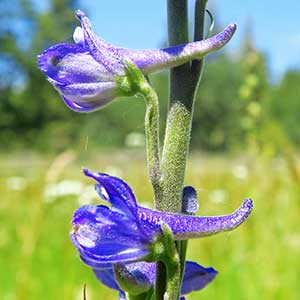Delphinium distichum
Delphinium geyeri
Burke's larkspur, meadow larkspur, strict larkspur, two-spike larkspur
Geyer's larkspur, poisonweed
(25-)30-60(-80) cm;
base sometimes reddish, puberulent.
(15-)30-60(-80) cm;
base usually reddish, puberulent.
blade cuneate to semicircular, 1-5 × 1.5-7 cm, puberulent; ultimate lobes 5-19, width 2-8(-15) mm (basal), 0.5-3(-5) mm (cauline);
margins of basal leaf, measured less than 1 cm from blade base, demarcating considerably more than 90° of arc when leaf laid flat;
most cauline leaf blades exceeding internodes.
blade light green, ± round, 1-5 × 1-6 cm, densely pubescent; ultimate lobes 7-20, width 2-5 mm (basal), 2-4 mm (cauline), apex gradually tapering to point;
veins obscure.
8-30(-40)-flowered, usually dense;
pedicel 0.5-1.5 cm, puberulent;
bracteoles 0-3 mm from flowers, green to blue, linear, 4-8 mm, puberulent.
6-30(-60)-flowered, ± open, cylindric;
pedicel ascending to spreading, 1-3(-4) cm, puberulent;
bracteoles 1-3 mm from flowers, green, lanceolate, 3-6 mm, puberulent.
sepals dark blue to bluish purple, puberulent, lateral sepals ± erect, 8-12 × 3.5-5 mm, spurs straight, horizontal or nearly so, 9-15 mm;
lower petal blades ± covering stamens, 4.5-6.5 mm, clefts 2-3 mm;
hairs centered mostly near base of cleft, white.
sepals bright blue, puberulent, lateral sepals spreading, 10-18 × 4-8 mm, spurs straight to slightly downcurved, ascending 0-30°, 11-16 mm;
lower petal blades slightly elevated, ± exposing stamens, 4-8 mm, clefts 0.5-2 mm;
hairs centered, densest on inner lobes near base of cleft, white to light yellow.
7-13 mm, 3.5-4 times longer than wide, ± puberulent.
11-15 mm, 3-3.5 times longer than wide, sparse puberulent.
seed coat cells with surfaces roughened.
unwinged;
seed coat cells with margins straight, surfaces ± roughened.
= 16.
= 16.
Delphinium distichum
Delphinium geyeri
Delphinium distichum hybridizes with D. multiplex and D. nuttallianum (D. ×diversicolor Rydberg). The name D. burkei has often been misapplied to D. distichum.
(Discussion copyrighted by Flora of North America; reprinted with permission.)
Apparently closely related to Delphinium stachydeum, D. geyeri is generally smaller, earlier flowering, with more finely dissected leaves and a more eastern geographic distribution.
(Discussion copyrighted by Flora of North America; reprinted with permission.)
- Local floras:
BC,
OR,
WA
- Local Web sites:
Flora NW,
PNW Herbaria
WildflowerSearch
iNaturalist (observations)
USDA Plants Database
- LBJ Wildflower Center
- SEINet
- Plants of the World Online
- Encyclopedia of Life
- Wikipedia
- Google Image Search


